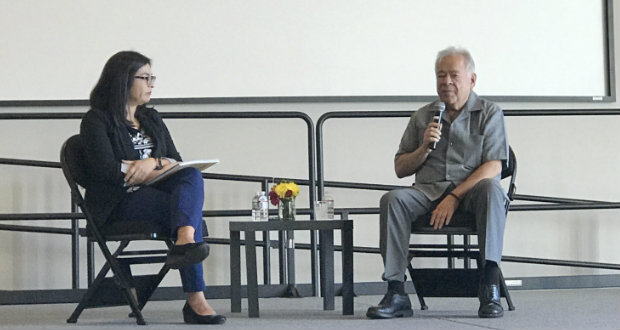The presence of Latinos in Hollywood today is nearly nonexistent.
And to Moctesuma Esparza, veteran filmmaker and activist, Latinos are “worse off in representation and employment in Hollywood than they were in 1950.”
On Wednesday, during an event celebrating the 20th anniversary of “Selena,” which featured a discussion and Q&A with its producer in the North Gym Room 118, Esparza spoke about how the film came to be and also gave advice on diversifying Hollywood.
On March 31, 1995, Mexican American singer Selena Quintanilla died of a gunshot wound in Corpus Christi, Texas. She was only 23 years old, but by then had established herself as an accomplished musician.
Millions in album sales, multi-platinum records, seven number one singles and a number of awards including a Grammy, Selena was not only the queen of the Tejano music scene but an icon in the Latin community.
Tonantzin, Esparza’s daughter, was a devoted fan. After Selena’s death, she came to the conclusion that her father should be the one to tell Selena’s story.
Growing up in Boyle Heights, near Los Angeles, Esparza comes from a modest working class family. His father, a farmworker, immigrated to the United States in 1918.
He was one of the organizers of the 1968 East L.A. student walkouts — a movement for equality and civil rights of Mexican Americans. He was later indicted for “conspiracy to commit a misdemeanor.” But ultimately, the case was thrown out.
Esparza’s role and the movement is memorialized in his 2006 HBO film “Walkout.”
Before graduating from UCLA, Esparza won his first Emmy for his thesis, a documentary called “Cinco Vidas/Five Lives” that was aimed at the exploration of the Chicano civil rights movement through individual portraits.
Esparza began producing bilingual segments for PBS children’s program “Villa Alegre” straight out of college and with an Emmy under his belt. It was during this process that Esparza said he figured out that he wanted to be a producer.
Following “Villa Alegre,” Esparza started his own company, Esparza-Katz Productions. He said his first movie that gained national attention was the 1982 film, “The Ballad of Gregorio Cortez,” starring Edward James Olmos.
“You can support the movies that come out that you love, that have Latinos in them,” he said. “And you can write and email the studios when you see movies that you don’t like, that have negative images of us.”
Esparza said denying movies our money is a power we all have, as well as speaking out and demanding how we want our community portrayed on screen.
When it came to producing the “Selena” film, Esparza did not show interest at first.
“I was concerned that Hollywood was going to be interested in the tragedy, the murder,” he said. “And that they were going to want to do the story of the murder.”
Despite everything, Tonantzin remained adamant. To try to change his mind, she gave him documentaries to watch and CDs to listen to.
Later, an idea popped into his head once he began to show appreciation for Selena’s legacy: “I could see a movie about a family that was fighting for the American dream.”
Esparza said the film was not going to be about Selena’s story, but about the Quintanilla family. By telling the story of the family, he was doing right by Selena. Esparza felt that approach was going to uplift people’s minds.
Esparza later reached out to Selena’s father, Abraham Quintanilla. He was one of various producers looking to secure rights to make the film.
Many offers were turned down. And there was one offer deep in negotiations. Esparza offered to be Quintanilla’s consultant, and they grew closer as a result.
Esparza said he then proposed a partnership in which Quintanilla would have complete approval of the script, the cast, the writer and the director.
Esparza’s kind of proposal was unheard of, he said. It was one that no major movie studio would agree to, but that did not stop him from taking a leap of faith. The result ultimately paid off after Quintanilla signed a deal with Esparza’s company.
While he was reluctant of director Gregory Nava, Quintanilla learned that his movies often contained tragedy, but ultimately were hopeful.
With a secure written plot, director and cast, Esparza searched for funding. Warner Bros. granted them a budget of $20 million.
Without changing one word of the film script, Quintanilla approved it. The agreement among Esparza, his partner and the Quintanilla family was that there would be no censorship.
Esparza said filming was painful for the family at times, in particular the hospital scene in which they learn that Selena has died.
“[Quintanilla] did not want his family to have to live through that again,” he said during the discussion.
Esparza promised Quintanilla editorial privileges as to how the sequence would be edited, and the scene was shot in one take. “When we finally edited the movie, he did not disapprove.”
Esparza said he took a lot of risks by giving up creative controls that normally a producer holds. But in order for “Selena” to be made, there had to be a lot of trust among those involved.
He was asked by an audience member if he would make any changes in the story, and Esparza said: “The movie has remarkable power, fidelity, and the fact that we’re here twenty years later talking about it and people want to see it, is a testament to its unique power.”




